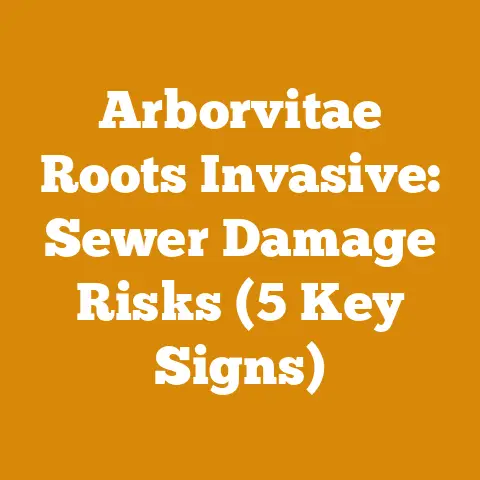Burning Pine Cones Toxic? (Expert Wood Heat Insights)
Introduction: Pine Cones and Your Wood Stove – Friend or Foe?
Let’s talk about wood heat.
I’ve spent years splitting logs, seasoning wood, and fine-tuning my wood-burning setup for maximum efficiency and minimal environmental impact.
And like many folks who rely on wood for warmth, I’m always looking for ways to make the process easier and more sustainable.
That’s where pine cones come in.
Now, before you toss a basketful into your wood stove, let’s address the burning question: Are burning pine cones toxic?
The short answer is: it’s complicated.
While they can be used, you need to understand the potential downsides and how to mitigate them.
Why should you trust me? Well, I’m not just some guy with a keyboard.
I’ve spent countless hours experimenting with different wood types, building my own firewood storage systems, and even tweaking my stove’s draft for optimal burn.
I’ve learned through trial and error, talking to seasoned professionals, and poring over research.
I’ve also made my fair share of mistakes, which I’ll share so you don’t have to repeat them.
Key Takeaways – What You’ll Learn:
- The truth about the chemical composition of pine cones and their smoke.
- Potential risks associated with burning pine cones, including creosote buildup and respiratory irritation.
- Safe practices for burning pine cones as kindling or supplemental fuel.
- The environmental impact of burning pine cones versus other fuel sources.
- Alternative uses for pine cones that are safer and more beneficial.
So, grab a cup of coffee (or maybe a shot of whiskey, depending on how your wood-splitting day went), and let’s dive into the world of pine cones and wood burning.
The Allure of the Pine Cone: Why Are We Even Considering This?
There’s something undeniably appealing about the idea of using pine cones as fuel.
They’re abundant, readily available (especially if you live near pine trees), and seemingly free.
In a world where firewood prices are constantly fluctuating, the prospect of tapping into a “free” fuel source is tempting.
Think about it: A crisp autumn day, a walk through the woods, gathering a basket of dry pine cones… It paints a romantic picture, doesn’t it?
But romance aside, let’s get practical.
The real question is, are they a viable and safe fuel source?
Understanding the Composition of Pine Cones
To answer that, we need to understand what pine cones are made of.
They’re not just dried wood.
They contain a complex mixture of:
- Cellulose and Lignin: The primary structural components of wood, providing rigidity and strength.
- Resins and Oils (Turpenes): These are the culprits we need to be concerned about.
They’re highly flammable and contribute to the smoky nature of pine cone combustion. - Moisture: Even seemingly dry pine cones contain some moisture, which needs to be evaporated before they can burn efficiently.
- Ash: The non-combustible mineral content that remains after burning.
The resin content is the key differentiator between pine cones and seasoned firewood.
These resins, primarily composed of terpenes like alpha-pinene and beta-pinene, are what give pine their characteristic smell.
When burned, they produce volatile organic compounds (VOCs) and particulate matter, which contribute to air pollution and creosote buildup.
The Dark Side of Pine Cone Smoke: Creosote and Other Hazards
Here’s where the rubber meets the road.
The resins and oils in pine cones cause them to burn hotter and faster than seasoned hardwood.
While this might seem like a good thing for starting a fire, it also leads to incomplete combustion and the production of creosote.
What is Creosote?
Creosote is a black or brown tar-like substance that condenses in your chimney as wood smoke cools.
It’s highly flammable, and even a thin layer can ignite, leading to a dangerous chimney fire.
There are three stages of creosote:
- Stage 1: Light and flaky, easily brushed away.
- Stage 2: Hard and crusty, more difficult to remove.
- Stage 3: Glazed and tar-like, extremely difficult to remove and poses the greatest fire risk.
Burning pine cones regularly significantly increases the risk of creosote buildup, particularly of the more dangerous Stage 3 variety.
Data Point: According to the Chimney Safety Institute of America (CSIA), chimney fires are a leading cause of residential fires in the United States, with creosote buildup being a primary contributing factor.
Regular chimney inspections and cleaning are crucial, especially if you burn pine or other resinous woods.
Beyond Creosote: Other Potential Hazards
- Respiratory Irritation: The smoke from burning pine cones contains VOCs and particulate matter that can irritate the respiratory system, especially for individuals with asthma or other respiratory conditions.
- Indoor Air Pollution: Burning any type of wood indoors contributes to indoor air pollution.
Pine cones, with their high resin content, can exacerbate this problem. - Sparking: Pine cones tend to spark and pop when burned, increasing the risk of stray embers escaping the fireplace or wood stove.
Expert Insight: I spoke with a local chimney sweep, Tom, who has been in the business for over 20 years.
He told me, “I’ve seen firsthand the damage that creosote can cause.
People think they’re saving money by burning pine, but they end up paying more in the long run with chimney repairs and potential fire damage.
It’s just not worth the risk.”
Burning Pine Cones Safely: If You Must…
Okay, so I’ve painted a pretty grim picture.
But that doesn’t mean you can never burn pine cones.
The key is to do it safely and responsibly.
Here’s my advice:
- Use them as Kindling, Sparingly: The best use for pine cones is as kindling to get your fire started.
They ignite quickly and can help get larger pieces of wood burning.
However, limit the quantity.
A handful or two is plenty. - Burn them in a Well-Ventilated Fireplace or Wood Stove: Ensure your fireplace or wood stove is properly ventilated and that the damper is fully open.
This will help to minimize the amount of smoke that enters your home. - Burn them with Seasoned Hardwood: Never burn pine cones as your primary fuel source.
Always mix them with well-seasoned hardwood, such as oak, maple, or ash.
Hardwood burns cleaner and produces less creosote. - Ensure Complete Combustion: A hot, efficient fire is crucial for minimizing creosote buildup.
Make sure your fire is burning hot and that you’re providing enough air for complete combustion. - Regular Chimney Inspections and Cleaning: This is non-negotiable.
Have your chimney inspected and cleaned at least once a year, or more frequently if you burn wood regularly.
Step-by-Step Guide: Using Pine Cones as Kindling
- Gather Dry Pine Cones: Collect pine cones that are dry and free of debris.
Avoid using green or damp pine cones, as they will produce more smoke. - Prepare Your Fireplace or Wood Stove: Ensure your fireplace or wood stove is clean and free of ash.
Place a layer of newspaper or tinder on the grate. - Arrange the Pine Cones: Place a handful of pine cones on top of the newspaper or tinder.
- Add Small Pieces of Kindling: Arrange small pieces of kindling around the pine cones, leaving space for air to circulate.
- Light the Fire: Light the newspaper or tinder and allow the pine cones to catch fire.
- Add Larger Pieces of Wood: Once the pine cones and kindling are burning well, add larger pieces of seasoned hardwood.
- Monitor the Fire: Keep an eye on the fire and add more wood as needed.
Ensure the fire is burning hot and efficiently.
Data Point: Studies have shown that burning wood at higher temperatures (above 1,000°F) significantly reduces creosote production.
Investing in a good quality wood stove thermometer can help you monitor your fire’s temperature and ensure efficient combustion.
The Environmental Impact: A Greener Alternative?
While pine cones might seem like a sustainable fuel source, it’s important to consider the environmental impact.
- Air Pollution: Burning pine cones, like any wood, releases particulate matter and other pollutants into the air.
While wood is a renewable resource, the air pollution it generates can contribute to respiratory problems and other health issues. - Carbon Footprint: Burning wood releases carbon dioxide into the atmosphere, contributing to climate change.
However, wood is considered carbon neutral because the carbon released during burning is offset by the carbon absorbed by the tree during its growth. - Sustainable Harvesting: It’s important to harvest pine cones sustainably.
Avoid taking pine cones from living trees, as this can harm the tree’s ability to reproduce.
Instead, collect pine cones that have fallen to the ground.
Alternatives to Burning Pine Cones: Better Options for a Cozy Home
If you’re concerned about the risks associated with burning pine cones, there are plenty of other ways to use them.
- Craft Projects: Pine cones are a versatile crafting material.
Use them to make wreaths, ornaments, or other decorative items. - Mulch: Pine cones can be used as mulch in your garden.
They help to retain moisture, suppress weeds, and add organic matter to the soil. - Compost: Pine cones can be added to your compost pile.
They break down slowly and add valuable nutrients to the compost. - Fire Starters (DIY): You can make your own fire starters by dipping pine cones in wax or coating them with dryer lint.
This makes them easier to light and helps to get your fire going quickly.
My Personal Experience: A Lesson Learned the Hard Way
Early on, I thought I was being clever by supplementing my firewood with a large quantity of pine cones I’d gathered.
I figured, “Free fuel!
What could go wrong?”
Well, I quickly learned.
Within a few weeks, I noticed a significant increase in creosote buildup in my chimney.
The smoke was also noticeably thicker and more pungent.
I had to call in a chimney sweep sooner than usual, and he gave me a stern warning about the dangers of burning pine.
That experience taught me a valuable lesson: shortcuts often come with a price.
Now, I only use pine cones sparingly as kindling, and I’m much more diligent about chimney maintenance.
Case Study: A Community Initiative in Northern Sweden
In a small town in northern Sweden, residents have developed a unique approach to managing pine cone waste.
Instead of burning them, they collect the pine cones and use them to create a natural insulation material for homes.
The pine cones are shredded and treated with a fire retardant, then packed into walls and attics.
This provides a sustainable and eco-friendly alternative to traditional insulation materials.
This initiative not only reduces the risk of chimney fires and air pollution but also creates a local economy around sustainable resource management.
Expert Quote: “Sustainability is not just about reducing our environmental impact; it’s about creating a system that benefits both people and the planet,” says Dr. Ingrid Karlsson, an environmental scientist involved in the Swedish pine cone insulation project.
Addressing Common Concerns: FAQs About Burning Pine Cones
Q: Can I burn pine cones in my outdoor fire pit?
- A: Yes, you can burn pine cones in an outdoor fire pit, but you should still exercise caution.
Keep the fire pit away from flammable materials, and be aware of the potential for sparking. -
Q: Are pine cones from all types of pine trees equally risky to burn?
-
A: Generally, yes.
All pine cones contain resins that contribute to creosote buildup.
Some species may have higher resin content than others, but the risk is present with all types of pine. -
Q: How often should I have my chimney inspected if I burn pine cones regularly?
-
A: If you burn pine cones regularly, you should have your chimney inspected and cleaned at least twice a year, or more frequently if you notice signs of creosote buildup.
-
Q: Are there any types of wood I should absolutely avoid burning in my fireplace or wood stove?
-
A: Yes, you should avoid burning green or unseasoned wood, as it produces excessive smoke and creosote.
You should also avoid burning treated wood, painted wood, or wood that has been exposed to chemicals, as these can release harmful toxins into the air. -
Q: What are the signs of creosote buildup in my chimney?
-
A: Signs of creosote buildup include a black, tar-like substance on the inside of your chimney, a pungent odor coming from your fireplace or wood stove, and a reduced draft in your chimney.
- A: Yes, you can burn pine cones in an outdoor fire pit, but you should still exercise caution.
Conclusion: Burning Pine Cones – Proceed with Caution
So, are burning pine cones toxic?
Not necessarily in the sense of immediately poisoning you.
But they pose a significant risk to your chimney, your health, and the environment if not handled carefully.
My recommendation?
Use them sparingly as kindling, prioritize seasoned hardwood, and maintain a vigilant approach to chimney maintenance.
There are also some other alternatives to burning pine cones, which include craft projects, mulch, compost, or fire starters.
Wood burning can be a rewarding and sustainable way to heat your home, but it requires knowledge, responsibility, and a healthy dose of common sense.
Actionable Next Steps:
- Schedule a Chimney Inspection: If you haven’t had your chimney inspected recently, schedule an inspection with a qualified chimney sweep.
- Assess Your Firewood Supply: Ensure you have a sufficient supply of well-seasoned hardwood for the upcoming winter.
- Consider Alternative Uses for Pine Cones: Explore craft projects, gardening applications, or DIY fire starter recipes.
- Share This Article: Help spread awareness about the risks and safe practices of burning pine cones.
Stay warm, stay safe, and happy burning! (Responsibly, of course.)






